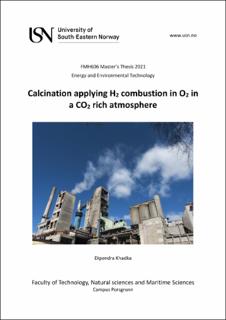| dc.description.abstract | The cement industry is one of the leading producers of anthropogenic greenhouse gases, the most important of which is CO2. Strong mitigation measures must be introduced to reduce substantial CO2 emissions from the cement industries. And one of many options to reduce CO2 emission is to keep direct combustion in the calciner to decarbonize raw meal used in the industry to produce cement clinker by combusting hydrogen fuel rather than carbon containing fuels which will not only eliminate CO2 formation as a result of fuel combustion but also provide a basis for simple capture of CO2 produced by calcination, as CO2 is the only gas that exits from calciner. For this purpose, this thesis research that deals with the calcination of raw meal using H2 combustion in O2 in a CO2 rich atmosphere was carried out.
To study the major impacts in a regular cement kiln process due to the substitution of carbon containing fuel by hydrogen and oxygen fuel, literature study was carried out on a various topics including water electrolysis technologies, safety aspects related to production, handling and storage of hydrogen and oxygen fuel in a cement kiln environment, terminal settling velocity of the raw meal particles and adiabatic flame temperature. A mass and energy balance for steady-state conditions was performed using MATLAB to measure relevant temperature, flow rates, and duties in our modified cement calciner system and heat exchanger. The design basis values were chosen identical to that of Norcem, Brevik.
The major parameters, including terminal settling velocity based on the maximum particle size i.e. 1000 (design basis value) and the gas velocity in the calciner were determined to ensure that the raw meal particles are completely entrained from our modified cement calciner system.
The calculation of the adiabatic flame temperature as a result of specific fuel i.e. coal/air combustion implied to calcine the raw meal in Norcem and the adiabatic flame temperature as a result of H2 combustion in O2 in a CO2 rich atmosphere was done using spyder (Python). The main purpose of this calculation was to maintain the substituted fuel’s adiabatic flame temperature in our specified system same as the regular coal/air fuel for combustion by adjusting the recycle ratio of CO2 recycling back to the calciner. As a result of Python plot, recycling of 1.538 moles of CO2 back to the calciner for every one mole hydrogen and half mole of oxygen fuel combustion was found to be appropriate to maintain the identical flame temperatures.
The other primary goal of this thesis research was to determine the extent to which constructional changes were required for the existing calciner. Two options were concluded based on the results of our design calculation to ensure that the raw meal particles are fully entrained from our new calciner system. The first option is to decrease the diameter of the calciner in comparison to the existing calciner, which raises the CAPEX value while adjusting the recycle ratio of CO2 to its lower limit i.e. 0.1 resulting
in lower OPEX value for our new system. The second option is to ensure that the maximum size of raw meal limestone particles entering the calciner is less than or equal to 500 and to adjust the CO2 recycle ratio to a corresponding value of 0.6, taking into account the current existing calciner with no constructional changes. The total amount of hydrogen and oxygen fuel required were calculated based on the appropriate recycle ratio, and the required capacity and the number of water electrolysis cells needed for our specified system were determined. NEL ASA’s commercially available atmospheric alkaline water electrolyzer was choosen for our system.
The cost of the water electrolyzer and CO2 fan as per required capacity was estimated. Centrifugal radial fan for the purpose to recycle the required amount of CO2 back to calciner was considered for this project. The annual equivalent capital and operational costs were estimated considering both the appropriate design options mentioned above. Finally, the cost per mass of CO2 avoided were calculated. | |
